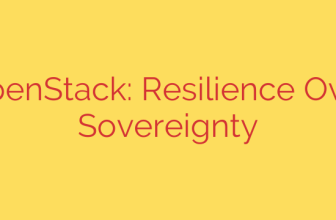
Integrating a robust, scalable storage backend is crucial for building a resilient and high-performance cloud infrastructure using OpenStack. One of the most popular and effective choices is leveraging Ceph as the unified storage solution for various OpenStack services. This provides a powerful foundation, offering durability, flexibility, and scalability that traditional storage systems often struggle to match in a dynamic cloud environment.
A key area of integration involves block storage, managed within OpenStack by the Cinder service. By configuring Cinder to use the Ceph RBD (RADOS Block Device) driver, you enable the provisioning of volumes for virtual machines and applications directly from your Ceph cluster. This setup benefits significantly from Ceph’s distributed nature, enhancing performance and availability compared to using local disks or less flexible shared storage solutions. Implementing this requires careful configuration of Ceph clients on the Cinder nodes and ensuring proper authentication using cephx keys for secure access to the Ceph pools designated for volumes. Features like creating snapshots and cloning volumes become highly efficient operations leveraging Ceph’s underlying capabilities.
Similarly, the Glance image service, responsible for managing virtual machine images, can utilize Ceph for storing image data. Storing images in Ceph pools allows for efficient retrieval and distribution. When combined with booting instances from Cinder volumes backed by Ceph RBD, this enables incredibly fast instance provisioning through Ceph’s native cloning functionality. Alternatively, the Ceph RGW (RADOS Gateway), compatible with S3 and Swift APIs, can serve as an object storage backend for Glance, offering another layer of flexibility and unified management.
Beyond persistent storage, integrating Nova, the compute service, with Ceph enables using Ceph RBD for ephemeral disks associated with instances that boot from images. This configuration is particularly valuable for achieving smooth live migration of instances, as the ephemeral disk data resides within the highly available and accessible Ceph cluster rather than on potentially isolated compute node storage. Configuring this involves deploying Ceph clients on the compute nodes and updating Nova’s settings to point to the appropriate Ceph pool for ephemeral data.
The collective benefits of tightly integrating OpenStack with Ceph are substantial. You gain a unified storage platform capable of handling block, object, and even file storage needs (via CephFS for services like Manila). This simplifies management, reduces operational overhead, and allows for a more cost-efficient infrastructure by running on commodity hardware. The inherent scalability and high availability of Ceph ensure that your cloud storage can grow with your demands and remain accessible even in the face of hardware failures, providing a robust backbone for your OpenStack cloud. Proper setup, including defining storage pools and managing users and authentication, is fundamental to unlocking the full potential of this powerful combination.
Source: https://kifarunix.com/part-2-integrate-openstack-with-ceph-storage-cluster/








